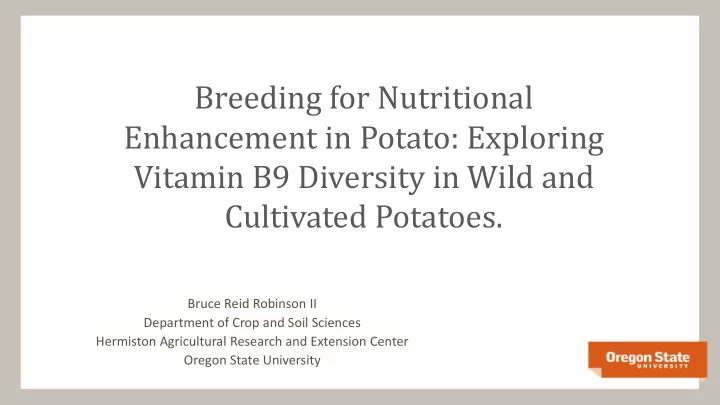

Breeding for Nutritional Enhancement in Potato: Exploring Vitamin B9 Diversity in Wild and Cultivated Potatoes. Bruce Reid Robinson II Department of Crop and Soil Sciences Hermiston Agricultural Research and Extension Center Oregon State University
Folate – Water Soluble Vitamin B9 Source: Scott & Weir 1998
Folate – Water Soluble Vitamin B9 Source: Scott & Weir 1998
Folate – Water Soluble Vitamin B9 Source: Scott & Weir 1998
Folate Sources and Deficiency • Folate deficiency has been linked to: -Neural Tube Defects (NTDs) such as spina bifida and anencephaly -Cardiovascular diseases -Stroke -Anemia -Development of certain types of cancers -Impaired cognitive performance http://1.bp.blogspot.com/- b6DLI8NfcXI/U6GT6qnJDII/AAAAAAAAAHo/PHoPkBjH6f0/s1600/sources+of+folate.png
Biofortification Through Breeding • Has additional advantages compared to industrial fortification alone: - Cost-effective - Sustainable - Can impact areas that lack the political will, infrastructure, and money to utilize current fortification practices • Requires that the target of the biofortification is a staple crop • Requires that this crop demonstrates natural variation, stability, and heritability for the trait you are breeding for
Why Potatoes? • Currently a 148g serving of potato (a medium sized potato) only provides about 6% of the 400µg RDA of folate • There are approximately 200 tuber bearing Solanum species representing enormous genetic diversity • Exploiting this variation between species is the paradigm for modern crop improvement, yet potatoes have not been a major focus of biofortification studies until now
Folate Content Variability in Potatoes • Wild type and primitive cultivated species show the greatest range of folate content • Some demonstrate significantly higher levels of folate over modern cultivars Goyer A, Sweek K (2011)
Potato Materials – Wild and Primitive Cultivated Species • 285 individual plants from 95 accessions representing 10 species evaluated with Russet Burbank as control • Accessions were obtained from the U.S. Potato Genebank
Potato Materials – Wild and Primitive Cultivated Species Harvested Selections: 1. S. acuale (3 accessions) 2. S. boliviense (25 accessions) 3. S. candolleanum (3 accessions) 4. S. chacoense (2 accessions) 5. S. circaefollium (3 accessions) 6. S. demissum (3 accessions) 7. S. microdontum (3 accessions) 8. S. okadae (3 accessions) 9. S. tuberosum subsp. andigenum (9 accessions) 10. S. vernei (23 accessions)
Tri-Enzyme Extraction Method Freeze-dried Tuber Sample Homogenize in HEPES/CHES Buffer Heat (10min at 100 ° C) Ice Bath • General Principle: Folate species must be released from food matrices and Incubate with Protease (2hrs at 37 ° C) processed without degrading the sample Heat (5 min at 100 ° C) so determination can be performed Ice Bath Incubate with α -amylase and conjugase • HEPES/CHES buffer, protease, α - (2-3hrs at 37 ° C) amylase, and conjugase allow for this Heat (10min at 100 ° C) with reasonable throughput Ice Bath Centrifuge Storage at -80 ° C
Folate Determination • Microbiological Assay using L. Rhamnosus • Wells loaded with Folic Acid Medium, standards, or samples http://www.phenixresearch.com/images/EVG_MPU-8117_WL.jpg • Incubated for 18-24 hours • Read with microplate reader • Folate values calculated from standard curve
Wild and Primitive Cultivated Species Folate Distribution 140 Number of Individuals in Specified 120 S. vernei Range by Species 100 S. boliviense S. andigenum 80 S. okadae S. microdontum 60 S. demissum S. acaule 40 S. candolleanum 20 S. chacoense S. circaeifolium 0 0-500 500-1000 1000-1500 1500-2000 2000-2500 Folate Concentration Range in ng/g DW
Wild and Primitive Cultivated Species Folate Distribution 140 Number of Individuals in Specified 120 S. vernei Range by Species 100 S. boliviense S. andigenum 80 S. okadae S. microdontum Vrn 558149 60 S. demissum Tbr 320377 Tbr 225710 S. acaule 40 S. candolleanum 20 S. chacoense S. circaeifolium 0 0-500 500-1000 1000-1500 1500-2000 2000-2500 Folate Concentration Range in ng/g DW
Wild and Primitive Cultivated Species Average Folate Concentration 1400 Normalized Average Folate Concentration 1200 1000 800 600 in ng/g DW 400 200 0 Species
Normalized Average Folate Concentration by Species 2500 Normalized Average Folate Concentration in ng/g DW 2000 1500 1000 500 0 S. circaeifolium S. chacoense S. candolleanum S. acaule S. demissum S. microdontum S. okadae S. andigenum S. boliviense S. vernei
Results • Wild and primitive cultivated species demonstrated an averaged range of 220 – 2200 ng/g folate based on dry weight • Highest measured individuals were in S. vernei and S. tuberorsum subsp. andigenum • If modern cultivars’ average folate concentration could be increased to 2000 ng/g dry weight or more this would represent a 4-5X increase https://the3amigoz.files.wordpress.com/2014/01/6761e-100_9485.jpg https://hauntingthelibrary.files.wordpress.com/2013/03/potato.jpg
Conclusions • Research demonstrates that there is genetic material with significantly higher folate concentration available for breeding purposes • Hybridization and evaluation of folate content in these materials will be necessary to determine: -Heritability of high folate traits -Which species and accessions are the most useful for this process • Further research is currently underway to try and establish molecular markers associated with high folate phenotypes
Acknowledgements • Dr. Aymeric Goyer • Dr. Vidyasagar Sathuvalli • Dr. Laurent Deluc • Dr. John Bamberg, US Potato Gene Bank • Solomon Yilma Funding Sources • National Institute of Food and Agriculture • USDA-Western Sustainable Agriculture Research and Extension Graduate Student Fellowship
Recommend
More recommend